This was published 7 years ago
Vancouver Island, Canada: More seafood than you can bear
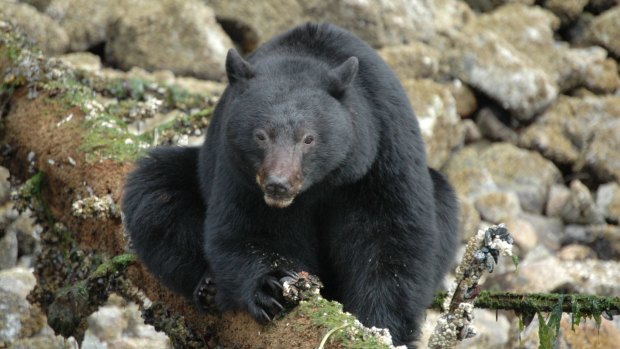
Some of the crabs the bears eat from under the rocks are as small as pieces of popcorn.Credit: Alamy
They dine well and they dine early in Clayoquot Sound. Day after day the main course is crab, served al fresco, with no rock left unturned to source the freshest produce. Such a diet could, of course, become a little monotonous, even though crab is quite the delicacy around these parts.
But here on Vancouver Island, a wild, remote and glorious corner of Canada and more or less British Columbia's equivalent of Tasmania, lying off Canada's west coast, it's the local bears, and not necessarily the humans, who eat this well this frequently.
Each day, in the hours leading to dusk, when the tide begins to recede and expose the rocks that form the shorelines of heavily forested islands that dot the pristine sheltered waters and bays of Clayoquot Sound, bears emerge into the open.
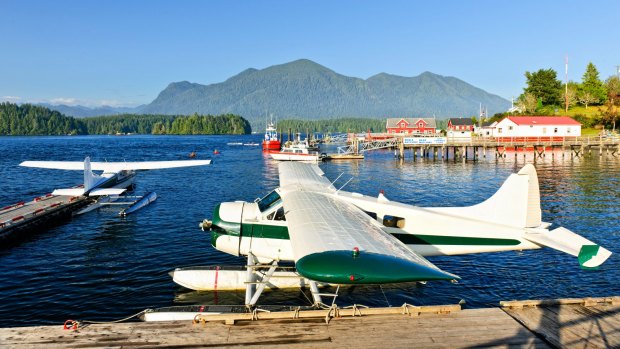
Seaplanes at dock in Tofino.Credit: Alamy
They come to feed on the shellfish, as well as clams and barnacles, that exist beneath the rocks, hunting them out with their characteristically elongated snouts and sharp claws.
Remote Passages, a company based in the township of Tofino, a five hours or so scenic drive from Victoria, the quaint capital of British Columbia, operates coastal black bear-watching tours aboard high-speed Zodiac inflatable boats. The company is aptly named since the next major landfall across from this part of Canada is Japan, straight across the Pacific Ocean.
Clayoquot Sound, which has been described as a world-class "ecological treasure" and is British Columbia's first UNESCO World Biosphere Reserve, encompasses nearly 300,000 hectares of old-growth rainforest.
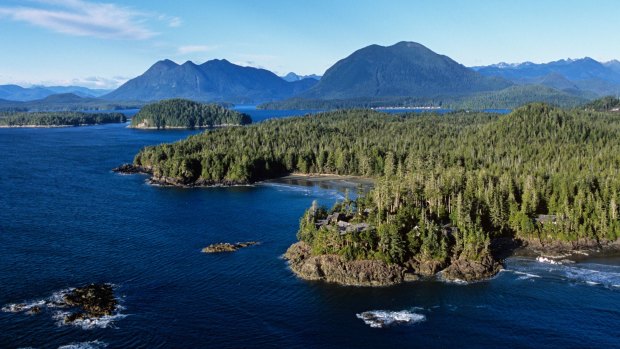
Clayoquot Sound, Vancouver Island, British Columbia.Credit: Alamy
It's home to dozens of endangered, threatened and vulnerable species of wildlife and with three quarters of Vancouver Island's old-growth forests already logged, Clayoquot Sound has become an important part of the country for Canadians to protect. Indeed, during the 1990s, controversies surrounding logging practices led to some of Canada's most volatile and divisive protests.
It's reassuring, then, to know that Remote Passages' style of bear-bothering doesn't bother the animals much at all as they go undisturbed with the distance between the shoreline and the vessels serving as a natural barrier.
Before we head off into Clayoquot Sound, with its backdrop of distant peaks with snow-flecked summits, from Remote Passages' waterfront base at Tofino, tour participants like me are rugged up. We've donned waterproof coverall flotation suits along with woollen beanies to protect against the windchill and seaspray, and in the unlikely event of a capsize or watery mishap.
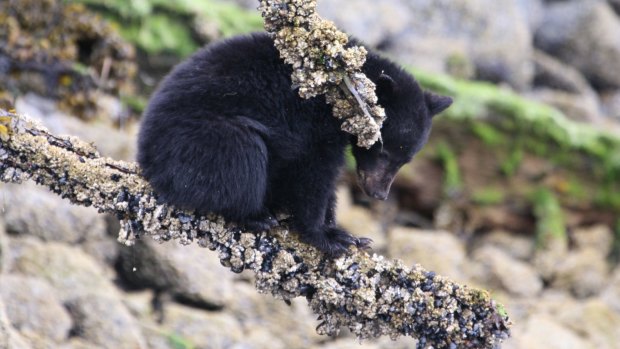
A black bear inspects the foreshore.Credit: Alamy
Once aboard the Zodiac, we leave Tofino and its high-rise exposed timber wharves, lined with fishing trawlers and float planes, behind us. Although it receives as many as a million visitors as year, the town manages to retain a certain Northern Exposure-like frontier town ambience. And it can be hard to reconcile that this is also a surfing town in a country better known for ski-suits than wet-suits.
It's October when I visit – mid autumn – and even though the maximum forecast temperature today is 15 degrees – relatively mild for this time of year. Yet once our Zodiac, named "Light Hawk" reaches its top speed, or thereabouts, the wind-chill attacks and we're grateful for those suits and beanies.
I imagine, too, that the bears appreciate their own thick black coats in these chilly months before their winter hibernation, which tends to begin in January and is shorter in these warmer climes than other parts of Canada.
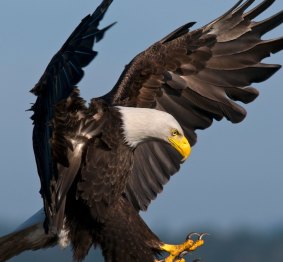
Adult bald eagle.Credit: Alamy
From our floating vantage point it's not long before we sight our first bears, two unmistakable black dots – one large and one small – lumbering across a rock-strewn shoreline. Our guide and skipper are sure not to get any closer to them than a distance of about 100 metres.
Next, we find another bear on the shoreline of an island but it flees back into the forest before we can obtain a better look, the guide explaining that it was likely disturbed not by our vessel but by an unknown something in the forest.
These bears, our guide informs us, are ostensibly more herbivorous foragers than carnivore hunters with some of those crabs that they devour under the rocks being as small as single pieces of popcorn. As we observe them, I'm still glad to have the water as a kind of moat between us so they aren't tempted to vary their diets.
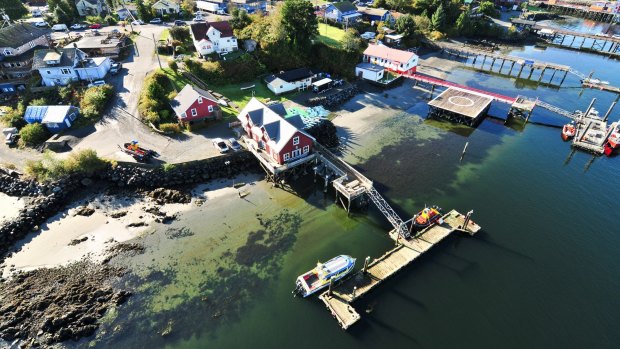
The picturesque town of Tofino. Credit: Alamy
From the Zodiac, bears can be hard to discern through the naked eye as they tend to blend into the rocks but there's little mistaking them through binoculars, as I watch as they employ, with an obvious well-practised dexterity, their huge frypan-sized paws to turn over rocks in search of a shellfish feast.
The pair, as we soon realise, are a mother and her cub, which can remain together for between one and two years before the younger bear ventures into the wild alone. It's estimated that there are as many as 120,000 black bears in the province of British Columbia with about 7000 living on Vancouver Island.
Black bears on Vancouver Island usually emerge from hibernation (which in reality is more a still rather mysterious deep sleep) by March and are visible by April – just in time for the bear-watching seasons – with mating usually occurring from early June.
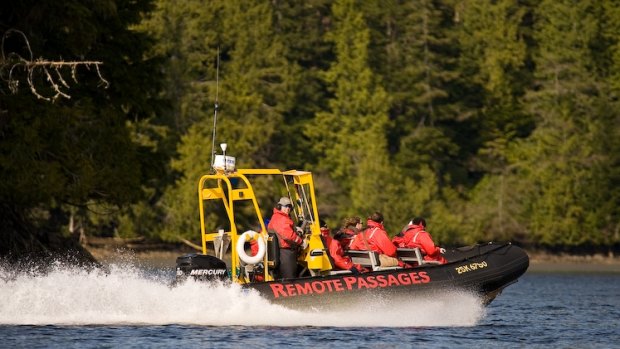
Heading out to spot the bears.Credit: Alamy
But in recent years wildlife experts have expressed concern about black bears on Vancouver Island emerging from hibernation earlier than usual. It means that there could be too little food so soon after winter, possibly threatening their survival.
Due to the more forgiving climate in this part of Canada the bears don't require the same kind of bulk as their cousins elsewhere and for the same reason they spend less time hibernating. Berries in summer form a significant part of the diet of these bears which, while not in the grizzly class, can weigh in at between 200 and 300 kilograms.
Yet this excursion is not all about bears, as we discover, since this part of Vancouver Island is also inhabited by plenty of other wildlife. At one point, as we're observing another distant bear, I hear a dog-like yelp and then a plip plop, plip, plop in the ocean behind the boat, which turns out to have been the sound from a seal close to the Zodiac.
Then, suddenly, our guide, spots a rare bald eagle, the national bird of the neighbouring United States, atop a red cedar tree. The guide turns the Zodiac sharply so its passengers can enjoy a better glimpse of the bird with its distinctive white-hooded plumage, pronounced yellow beak and, typical of birds of prey, intense countenance.
It's a been a rewarding and unforgettable afternoon of bear-spotting, with seven bears in total sighted. On the way back to town, as the sun begins to slip behind the islands of the Sound, the cold really starts to bite and my thoughts turn to my own dinner. Crab or clams somewhere in Tofino tonight sound appealing but, please, no al fresco dining and do hold the barnacles.
FIVE MORE THINGS DO IN TOFINO
EXPLORE PACIFIC RIM NATIONAL PARK RESERVE
More than 500 square kilometres of rugged coastlines and temperate rainforests, Pacific Rim National Park Reserve is a popular haunt of Canada's surfing community as well as nature-lovers from around the world. See pc.gc.ca
VISIT A CARVER'S STUDIO
One of the most surprising features of Wickaninnish Inn, Tofino's signature seaside luxury lodge that helped put the town on the tourism map, is the beachcomber's shack (dating to the 1970s) that it maintains for local carvers whose creations you can buy. See wickinn.com
DINE AT WOLF IN THE FOG
The chef at this lively restaurant, considered the best in Tofino, used to cook at Wickaninnish Inn before he opened his own two-storey diner in the town's main street with a fish and foraged-produce-focused menu. See wolfinthefog.com
CHASE A STORM
To stimulate tourism in the winter months, Tofino's canny tourism burghers created an industry around the spectacular and wild storms that strike this corner of Vancouver Island. Now storm-watching is a lucrative local feature of winter. See hellobc.com.au
GO WHALE WATCHING
Remote Passages, in addition to its bear-watching tours, also offers half-day tours to areas near Tofino where grey whales feed. Sightings of seabirds, including tufted puffins and bald eagles, are common, as are sea-lions, seals and porpoise. See remotepassages.com
TRIP NOTES
FLY
Air New Zealand operates regular flights from Sydney to Melbourne and other major Australian capitals to Vancouver, via Auckland, with Air Canada domestic connections to major Canadian cities such as Victoria, the main city on Vancouver Island. See airnewzealand.com.au and aircanada.com
TOUR
Remote Passages' coastal bear-watching tours depart from Tofino each afternoon between April and October with departure time dependent on tides. The tours cost $C105 for adults and $C79 for children between three and 12 years. Reservations are recommended. See remotepassages.com
STAY
The best place to stay in Tofino is Wickaninnish Inn, a luxury lodge with a spectacular ocean and beach-setting and views of the sometimes turbulent Pacific Ocean. Doubles start from $260 in winter with rates rising during the bear-watching season in the warmer months. See wickinn.com
MORE
Anthony Dennis travelled to Canada as a guest of Destination British Columbia.
Sign up for the Traveller Deals newsletter
Get exclusive travel deals delivered straight to your inbox. Sign up now.